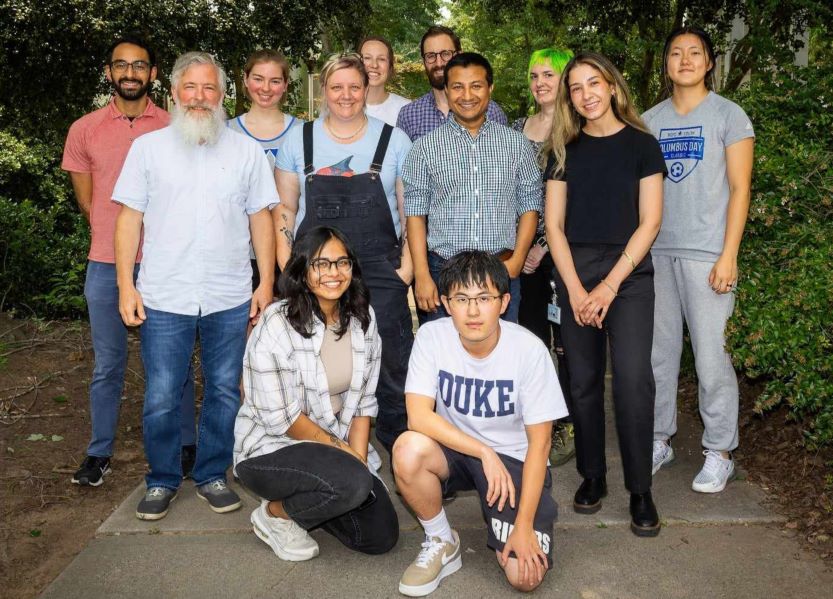Sommer Lab
Our laboratory studies circuits for cognition, with the goal of answering a fundamental question in neuroscience: How do the many, diverse parts of the brain interact to achieve visual perception and behavior? We focus on the role of the frontal cortex and its communication with other cortical and subcortical areas.
Techniques used in the lab include single neuron and population-level electrophysiology, optogenetics and other genetic methods, psychophysics, and computational modeling.
To translate our basic research into therapies for psychiatric and motor disorders, we apply our techniques to improve transcranial magnetic stimulation (TMS) and the efficacy of viral vectors for gene therapies. Members of the lab come from a wide range of disciplines including biomedical and electrical engineering, neurobiology, neuroanatomy, computer science, and more. Since the research done in our lab is highly interdisciplinary, our lab often collaborates with departments throughout Duke as well as with other institutions.
Lab Members

Alumni
Research Scientists
Corrie Camalier (2018-2019)
Postdoctoral Fellows
Suva Roy (2023; Sponsored guest post-doc working in my lab, from Field lab at UCLA)
Zachary Abzug (2018)
Hrishikesh Rao (2017)
Martin O. Bohlen (Pfizer-NCBiotech Fellow; Hartwell Foundation Biomedical Research Award
Fellow; 2016-2022)
Vincent Prevosto, Ph.D. (2010-2020)
Michael J. Koval, Ph.D. (2012-2014)
PhD Alumni
Hala El-Nehal (BME, MS 2016-2017. Ph. D candidate 2018-2025. Defended on March 24, 2025
Title: Oculomotor Roles of the Claustrum and its Projection to Frontal Cortex in Primates.)
Anthony Alers (BME Ph D. Candidate 2016-2024. Defended April 4 , 2024 Title: Neural basis of visuomotor learning in the frontal eye field: an integrated computational and neurophysiological approach.)
Joshua Stivers (Psychology & Neuroscience Ph.D. candidate, co-mentored with Roberto
Cabeza; 2018-2021)
Raveena Kothare (Duke BME Howard G. Clark III Fellow; BME Ph.D. candidate, 2016-2023;
finished with an MS in BME)
Divya Subramanian (Neurobiology Ph.D. candidate, 2016-2022; defended on March 24, 2022.
Title: Contributions of Bayesian and Discriminative Models to Active Visual Perception across
Saccades.)
Zachary Abzug (NSF Graduate Research Fellow; Duke Scholars in Neuroscience Program;
BME Award for Outstanding Doctoral Dissertation; BME Ph.D. candidate, 2011-2017; defended on November 3, 2017.
Title: The Neurocomputational Basis of Serial Decision-Making.
Hrishikesh Rao (NIH F31 NRSA Fellow; NSF Graduate Research Fellow; IGERT WISeNet
Fellow; BME Ph.D. candidate, 2011-2016; defended on October 14, 2016. Title: Bottom-up and Top-down Mechanisms of Visually-Guided Movements.)
Ramanujan Raghavan (2011-2016; Neurobiology Ph.D. candidate; co-mentored with Steve
Lisberger; defended dissertation on October 7, 2016. Title: Analysis of Purkinje Cell Responses in the Oculomotor Vermis during the Execution of Smooth Pursuit Eye Movements.).
PhD rotation students
Tracey Lee (Rotation GPMED, 2024)
Michael Harris (GPMED, 2024)
Ergi Spiro (Cognitive Neuroscience program, 2023)
Kennedy Coates (Neurobiology program, 2023)
Alev Brigande (Neurobiology program, 2022)
Joshua Stivers (Cognitive Neuroscience program, 2018)
David Murphy (Cognitive Neuroscience program, 2016)
Divya Subramanian (Cognitive Neuroscience program, 2015)
Sam Brudner (Cognitive Neuroscience program, 2015)
Jeffrey Mohl (Neurobiology program, 2014)
Charlie Giattino (Cognitive Neuroscience program, 2014)
Benjamin Geib (Cognitive Neuroscience program, 2013)
Jake Heffley (Neurobiology program, 2013)
Hanna Oh (Cognitive Neuroscience program, 2013)
Cassie Kozyrkov (Cognitive Neuroscience program, 2011)
Joseph Barter (Cognitive Neuroscience program, 2011)
Caroline Drucker (Neurobiology program, 2012)
Yilei Cai (Neurobiology program, 2012)
Masters Students
Michael Hamway (BME M.Eng. Program, 2024)
Alex Qian (Spring 2024 BME MS/MEng Research Fellow; BME M.S. Program, 2023-2024)
Kiran Shehnaz Kaur (BME M.S. Program, 2023)
Garima Iyer (BME M.S. Program, 2023)
Cassie Hammond (Spring 2023 BME MS/MEng Research Fellow; BME M.S. Program,
2023-2024)
Zhixing (Vincent) Dai (Fall 2022 BME MS/MEng Research Fellow; BME M.S. Program,
2021-2022)
Jingwen Deng (2020 Dean’s Research Award; 2020 BME MS/MEng Research Fellowship; BME
M.S. Program, 2020-2021)
Adrianna Battle (BME M.S. Program, 2019-2020)
Lucy Liang (BME M.S. Program, 2019-2020)
Zisheng (Jason) Liang (BME M.S. Program, 2018)
Lucas Hoffman (BME M.S. Program, 2018-2019)
Richard Chen (BME M.S. Program, 2018)
Aoxue (Mia) Miao (BME M.S. Program, 2018-2020)
Xiaoyu Tong (BME M.S. Program, 2018-2019)
Yi Zhao (BME M.S. Program, 2017-2018)
Brandyn Wong (BME M.S. Program, 2017-2018)
Hala El-Nahal (BME MS-MEng Research Fellow; BME M.S. Program, 2017, Currently Graduate
Student in Sommer Lab)
Josh Wu (BME 4+1 M.S. program, 2016-2018)
Neerav Goswami (BME M.S. program, 2015-2017; Currently a PhD student in Sommer Lab)
Dennis Wong (BME M.S. program, 2015-2017)
Erinn Grigsby (BME M.S. program, 2013-2015; successful oral defense of dissertation on
March 24, 2015. Title: The Effects of Transcranial Magnetic Stimulation (TMS) on the Neural
Activity of Awake Non-Human Primates.)
Matthew Frank (BME M.S. program, 2015)
Melina Smith (BME 4+1 M.S. program, 2014-2015)
Zachary Abzug (NSF Graduate Research Fellow; received MS on way to PhD, 2014)
Kimi Rafie (BME 4+1 M.S. program, 2013-2014)
Undergraduate Alumni
Dilnaz Dyussengaliyeva (2025)
Srinjoyi Lahiri (2025)
Sera Balkir (2025)
Dillion Heffernan (2024)
Carter Levine (2024)
Darienne Rogers (2024)
Neyla Kirby (2023)
Miles Bradley (2022-2023)
Angie Xie (2021-2022)
Apoorva Das (2020-2023)
Olivia Leggio (2021)
Amber Brooks (2020-2023)
Rahul Mukherji (2020-2021)
Philip Cho (2018-2021)
Gabriel Goldhagen (2020)
Brianna McCollum (REU Fellow from Tennessee State University; 2019)
Veronica Yuziuk (2019-2020)
Jason Chou (Pratt Fellow; Grand Challenges Scholar; 2018-2020)
Zongyu (Zoey) Li (2018)
Vincent Peng (2018-2019)
Luiza Wolf (2018-2019)
Mackenzie Marques (2018-2019)
Karen Ou (2018-2019)
Mary Zhang (2016-2019)
Jin Soo (Andrew) Byun (Computer Science, 2017-2018)
McKenzie Middlebrooks (Neuroscience Honors thesis project; 2016-2017)
Amy Xiong (Grand Challenges Scholar; 2016-2017)
Pum Wiboonsaksakul (Pratt Fellow; 2016-2017)
Sarah Proctor (BioCoRE Undergraduate Scholar; 2016-2019)
Jinsu “Jason” Kim (Pratt Fellow; Grand Challenges Scholar; Walter J. Seeley Scholastic Award;
Leonardo da Vinci Award; $25k in VentureWell grants for startup
(co-founder/lead engineer, Physao); Graduated with Distinction; 2015-2016)
Andrew Toader (Pratt Fellow; Graduated with Distinction; 2015-2016)
Minyoung Ryoo (Pratt Fellow; Grand Challenges Scholar; Accenture Scholar; Graduated with
Distinction; 2015-2016)
Andrew Freyberger (Pratt Fellow; 2015-2016)
Kimberly Eddleman (2015-2016)
Melina Smith (Pratt Fellow; Grand Challenges Scholar; 2014-2015; featured speaker at White
House BRAIN Initiative Conference in 2014)
Juwan Hong (Pratt Fellow; 2014-2015)
Gehua Tong (2015; BME/Neuroscience dual major)
Brie Jackson (BioCoRE Undergraduate Scholar; 2014)
Kenneth Padilla (REU Fellow from Puerto Rico; 2013)
Jessica Cao (Pratt Fellow; Graduated with Distinction; 2013-2014)
Amit Vora (Pratt Fellow; Graduated with Distinction; 2013-2014)
Fred Shen (Pratt Fellow; Graduated with Distinction; 2013-2014)
Radu Darie (Pratt Fellow; Grand Challenges Scholar; Graduated with Distinction; 2012- 2014)
Frank Lee (Pratt Fellow; 2012-2014)
Cole Arora (Pratt Fellow; 2012-2014)
Erinn Grigsby (Pratt Fellow; 2011-2013)
Kimi Rafie (Pratt Fellow; 2011-2013; Master’s student, graduated 2014)
Jennifer Villa (Pratt Fellow; Walter J. Seeley Scholastic Award; Leonardo da Vinci Award;
2012-2013)
Juan San Juan (Pratt Fellow; 2011-2013)
Brian Kohen (2011-2013)
Nicholas Jordan (summer student from Case Western University; 2012)
Qifang (Yvonne) Bi (2011-2012)
Sean Sketch (REU Fellow from Princeton University; 2011)
Catherine Hartman (2010; Then was a graduate student at Harvard University)
YiShin Chang (2011)
High School Students
Riya Sinha (2024)
Janie Qing (2024)
Amy Cheng (2018)
Grishma Patel (2018-2019)
Surasya Guduru (2017)
Anna Hattle (2015-2016)
Bailey Blankenship (2014-2015)
Volunteers:
Ashley Ontiri (2024-2025)
Associates in Research:
Tierney Daw (2019-2021)
Mackenzie Marques (2019-2020)
Neerav Goswami (2019-2020; Currently a PhD student in Sommer Lab)
Brandyn Wong (2019)
Hala El-Nahal (2018; Currently a PhD student in Sommer Lab)
Melina Smith (2015-2017)
Jerry Dahlke (2013-2014)
Frank W. Petraglia III (2010-2012)
Kedar Prabhudesai (2011-2012)
Tom Heil (2011)
Sommer Research
Team Corollary Discharge
The image of the world projected onto our retinas is jumpy because we frequently make rapid eye movements called saccades. But, somehow, the brain transforms this chaotic information into a continuous, stable percept. A key factor in this process is the relay of eye movement information, or corollary discharge, to the visual system. We study circuits for corollary discharge and their impact on visual processing using a combination of psychophysics, neural recordings, and computational robotics. In addition to revealing a fundamental component of visual perception, the results inform methods for stabilizing information in systems that use mobile cameras and other sensors.
Contact: Marc Sommer
Team Virus
New genetic technologies have revolutionized neuroscience, but primarily in small animal models such as mice. In the primate brain, genes need to be delivered by viruses, but making this work reliably has been surprisingly difficult for the field. The challenges have slowed down both viral-mediated research in non-human primates and gene therapies in humans. Our goal is to improve viral technologies for non-human primate research by evaluating the safety and efficacy of various viruses and their serotypes, improving the reliability of the viruses using techniques such as directed evolution and immunosuppression, mapping neural circuits with viruses that spread beyond the site of injection, and validating the functionality of the resulting tools for research and therapy.
Contact: Martin Bohlen
Team Optogenetics
With our improved viral methods, we are applying genetic technologies to control the activity of single neurons and specific neuronal populations using light. This work extends from rodent models to non-human primates. Our goal is to modulate the activity of very specific neuronal populations and circuits to determine their roles in cognition and behavior. Current projects include optogenetic studies of a specific class of retinal cells that project to the brainstem and a subset of neurons in the claustrum that project to prefrontal cortex. Much of this work is conducted in behaving animals to assess how optogenetic activation or inhibition of neural circuits affect perception, cognition, and action.
Contact: Hala El-Nahal (claustrum) or Marija Rudzite (retina)
Team TMS
Transcranial magnetic stimulation (TMS) is a safe, non-invasive form of neuromodulation in which a coil is placed near the head to produce a transient magnetic field that, in turn, induces a time-varying electric field in the brain. Although TMS is approved by the FDA for treatment of depression and migraine and is used widely in cognitive research, its underlying biological mechanisms of action are still poorly understood. Our lab investigates the neural basis of TMS effects to establish principles for rational design of its clinical applications. Our approach is to study the effects of various TMS protocols on single neurons and circuits in the rhesus macaque brain.
Contact: Neerav Goswami
Sommer Teaching
Current Courses
- BME 301L/NEUROSCI 301L: Biolectricity
- BME 517/NEUROSCI 507: Neuronal Control of Movement
- BME 790L: Bioelectrical Engineering
- NEUROBIO 720C: Concepts in Neuroscience II - Sensory/Motor Integration
- NEUROBIO 760S: Principles of Cognitive Neuroscience II
Sommer Publications
Goetz, Stefan M., Bryan Howell, Boshuo Wang, Zhongxi Li, Marc A. Sommer, Angel V. Peterchev, and Warren M. Grill. “Isolating two sources of variability of subcortical stimulation to quantify fluctuations of corticospinal tract excitability.” Clin Neurophysiol 138 (February 24, 2022): 134–42. https://doi.org/10.1016/j.clinph.2022.02.009.
Caruso, Valeria C., Daniel S. Pages, Marc A. Sommer, and Jennifer M. Groh. “Compensating for a shifting world: evolving reference frames of visual and auditory signals across three multimodal brain areas.” Journal of Neurophysiology 126, no. 1 (July 2021): 82–94. https://doi.org/10.1152/jn.00385.2020.
Liu, Sicong, Jillian M. Clements, Elayna P. Kirsch, Hrishikesh M. Rao, David J. Zielinski, Yvonne Lu, Boyla O. Mainsah, et al. “Psychophysiological Markers of Performance and Learning during Simulated Marksmanship in Immersive Virtual Reality.” J Cogn Neurosci 33, no. 7 (June 1, 2021): 1253–70. https://doi.org/10.1162/jocn_a_01713.
Tremblay, Sébastien, Leah Acker, Arash Afraz, Daniel L. Albaugh, Hidetoshi Amita, Ariana R. Andrei, Alessandra Angelucci, et al. “An Open Resource for Non-human Primate Optogenetics.” Neuron 108, no. 6 (December 23, 2020): 1075-1090.e6. https://doi.org/10.1016/j.neuron.2020.09.027.
Cushnie, Adriana K., Hala G. El-Nahal, Martin O. Bohlen, Paul J. May, Michele A. Basso, Piercesare Grimaldi, Maya Zhe Wang, Marron Fernandez de Velasco Ezequiel, Marc A. Sommer, and Sarah R. Heilbronner. “Using rAAV2-retro in rhesus macaques: Promise and caveats for circuit manipulation.” Journal of Neuroscience Methods 345 (November 2020): 108859. https://doi.org/10.1016/j.jneumeth.2020.108859.
Bohlen, Martin O., Thomas J. McCown, Sara K. Powell, Hala G. El-Nahal, Tierney Daw, Michele A. Basso, Marc A. Sommer, and R Jude Samulski. “Adeno-Associated Virus Capsid-Promoter Interactions in the Brain Translate from Rat to the Nonhuman Primate.” Human Gene Therapy 31, no. 21–22 (November 2020): 1155–68. https://doi.org/10.1089/hum.2020.196.
Gamboa Arana, Olga Lucia, Hannah Palmer, Moritz Dannhauer, Connor Hile, Sicong Liu, Rena Hamdan, Alexandra Brito, et al. “Intensity- and timing-dependent modulation of motion perception with transcranial magnetic stimulation of visual cortex.” Neuropsychologia 147 (October 2020): 107581. https://doi.org/10.1016/j.neuropsychologia.2020.107581.
Gamboa, Olga Lucia, Alexandra Brito, Zachary Abzug, Tracy D’Arbeloff, Lysianne Beynel, Erik A. Wing, Moritz Dannhauer, et al. “Application of long-interval paired-pulse transcranial magnetic stimulation to motion-sensitive visual cortex does not lead to changes in motion discrimination.” Neurosci Lett 730 (June 21, 2020): 135022. https://doi.org/10.1016/j.neulet.2020.135022.
Gamboa Arana, Olga Lucia, Hannah Palmer, Moritz Dannhauer, Connor Hile, Sicong Liu, Rena Hamdan, Alexandra Brito, et al. “Dose-dependent enhancement of motion direction discrimination with transcranial magnetic stimulation of visual cortex,” June 15, 2020. https://doi.org/10.1101/2020.06.14.151118.
Akbar, Navid, Mathew Yarossi, Marc Martinez-Gost, Marc A. Sommer, Moritz Dannhauer, Sumientra Rampersad, Dana Brooks, Eugene Tunik, and Deniz Erdoğmuş. “Mapping Motor Cortex Stimulation to Muscle Responses: A Deep Neural Network Modeling Approach.” In The ... International Conference on Pervasive Technologies Related to Assistive Environments : Petra ... International Conference on Pervasive Technologies Related to Assistive Environments, Vol. 2020, 2020. https://doi.org/10.1145/3389189.3389203.







